- Home
- Blog
- IBM API Connect
- IBM API Connect Tutorial

IBM API Connect is a comprehensive API management solution that covers all of the necessary features and tools for each stage of the API lifecycle. Critical components of the API lifetime include creating, securing, maintaining, socializing, and analyzing. IBM API Connect, the industry-leading API management tool, has version 10 with new capabilities. This release has improved the company developers' and cloud manager experiences and deployed in complex, multi-cloud topologies. This IBM API Connect tutorial is fundamental to studying and grasping its functions.
| If you want to enrich your career and become a professional in IBM API Connect, then enroll in "IBM API Connect Training" - This course will help you to achieve excellence in this domain. |
What is IBM API Management?
The process of building, publishing, and managing API connections in an enterprise and multi-cloud environment is called API management. API management provides a scalable, unified platform that allows businesses to share and socialize their API setups while limiting access, collecting and analyzing usage information, and enforcing security regulations.
The critical goals of IBM API Connect are to provide best-in-class API management tooling and a cloud-native solution. Users may now design, manage, and protect apps deployed in a range of on-premises and cloud environments.
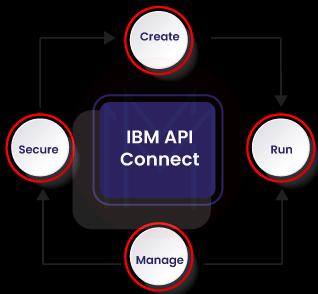
Features of IBM API Connect
Listed are the advanced features of IBM API Connect
-
Deploy multi-cloud
Get the flexibility and consistency you need to run on-premises, in the cloud, or in a hybrid environment.
-
Hardened security for APIs
Various standards can help secure, regulate, and mediate your APIs (REST and non-REST).
-
API product management
Bundle APIs into monetizable products to boost the value of your digital assets.
-
Cloud-scale performance
With a microservices-based cloud-native design, you can scale to fulfill SLAs.
-
API lifecycle management
Create, promote, and monitor APIs using an easy-to-use management console throughout their life cycles.
-
Self-service portal
Using a company-branded portal and socialization tools, reach internal and external API consumers.
-
API management
With the API manager user interface, you may manage APIs for internal usage or monetize and manage services.
-
IBM DataPower Gateway
Control and log API traffic and interactions while maintaining system performance. Handle complex integrations and support containers.
-
Developer portal
Developers' Detailed information about the appropriately may discover and subscribe to APIs through a company-branded site and register and deploy connected apps.
-
Developer toolkit
Get the tools you'll need to model, build, and test APIs before releasing them on IBM API Connect.
-
Cloud manager
APIs can configure, administer, and monitor your IBM API Connect on-premises cloud with a simple user interface.
Benefits of API Management
There are many benefits of using API Management in everyday life. Listed are the few benefits of API Management:
- APIs are not a new concept for many enterprises. However, for organizations that need to manage API integrations across a growing number of systems and apps, the time spent rebuilding these integrations from the ground up can be time-consuming and deplete internal resources.
- API management allows businesses to reuse API integration features with greater flexibility, saving time and money without compromising security.
- A significant advantage of adopting an API management solution is deploying and reusing integration elements swiftly.
- Enterprises may simply share the API documentation and coding constructs amongst teams by managing their APIs on one unified and centrally visible platform. This reduces development costs and time to market dramatically.
- API management solutions also aid in the security of current services by tracking API access and integrating cutting-edge security protocols such as OAuth, JWT, and OpenID.
API Management vs. Centralized ESB
The following are the key distinctions between API management and an ESB:
- API management technologies frequently have features and capabilities that an ESB does not.
- In contrast to ESBs, API management is more flexible and optimized for newer tech advances such as microservices.
- Consumption-based API management solutions are standard, although exposure-based ESBs are more common.
| Related Article: IBM API Connect Interview Questions |
IBM API Components
The API Connect components deliver a consistent user experience throughout the API lifecycle. Modifications in one phase of the API lifecycle are automatically mirrored in the other API Connect components. integratingBelow are the IBM API components and their definitions:
Cloud Manager
API Connect is a service that connects APIs. The API Connect on-premises cloud is managed via the Cloud Manager component. The Cloud Administrator uses this UI to manage (alter, move, remove, restart, and reboot). It can keep an eye on the cloud's health. Define and manage the API development provider organizations.
The developer toolkit
API developers construct draft API definitions for REST and SOAP APIs and OAuth provider endpoints for OAuth 2.0 authentication, using the API management features in the API Manager or the CLI. The API definitions can be customized to add the API to a Product, add a policy assembly flow (to alter requests/responses), and define security choices and other settings, among other things. APIs can then be evaluated locally before being published to confirm appropriately specified and implemented.
API Manager
The API Manager is a user interface that makes promoting and tracking APIs bundled as part of Products and Plans easier. API providers can control the availability and visibility of APIs and Plans and move products through their lifecycle. In the API Manager, Catalogs and Spaces are built as staging targets for publishing APIs, Plans, and Products to consumer organizations. API providers can publish their Products to make those Products public on a Developer Portal for external discovery by staging them to Catalogs or Spaces.
API Gateways
API Gateways enforce runtime policies to secure and regulate API traffic and provide endpoints that expose APIs to calling applications and assembly functions that allow APIs to interface with other endpoints. All API interactions are also logged and reported to the API Connect analytics engine, which allows for real-time and historical analytics and reporting.
Runtime
API Connect has a containerized runtime that you may use to run applications and API implementations.
- Containerized runtime
A containerized runtime environment provides a lightweight deployment site for APIs and applications. A container is a file system that contains everything a program needs to run, including code, runtime, system tools, and system libraries. To run API Connect-managed APIs and apps, you can utilize Docker Swarm or Kubernetes containers.
Developer Portal
Application developers can use the Developer Platform to explore, discover, and subscribe to APIs using a configurable self-service web-based portal. When API providers publish APIs in the API Manager, the APIs are made available in the Developer Portal for application developers in consumer companies to discover while using.
API Analytics
API Connect allows you to filter, sort, and aggregate data from your API events. This information is then provided in connected charts, tables, and maps to assist you in managing service levels, quotas, controls, security rules, community management, and trend analysis.
API Connect server requirements
You may create, promote, utilize, and track APIs from an on-premises cloud. An on-premises cloud comprises various appliances, each of which has specific server-type APIs. The number of servers in your cloud dictates how the task of managing, analyzing, routing, and storing data is distributed.
Typical tasks per-interface component
API Connect comes with both a command line and a graphical user interface. For everyday tasks, provider and consumer groups employ different interfaces.
API Connect Development Kit
The developer toolkit includes a command-line interface (CLI) and a graphical user interface (API Designer). LoopBack, an open-source Node.js framework, is used.
An API developer can use LoopBack to establish a Node.js application, connect to a data source to be consumed, such as a back-end database or a REST API, and then expose the application as a REST API by generating a model definition. A LoopBack model provides a REST API by default and defines the API’s application data, validation rules, data access capabilities, and business logic.
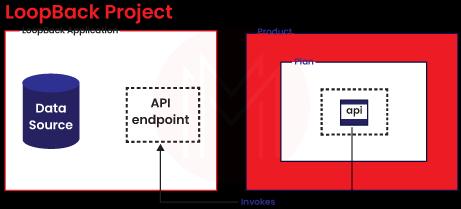
A REST API definition can then use this REST API developed using the API Designer or CLI and made available to your users. The API and its related application, implemented as a LoopBack project, must be published to launch the project. Local testing of LoopBack projects is also possible. The LoopBack project architecture is depicted in the diagram below:
APIs that call REST and SOAP Services
SOAP is a technology that was created before the introduction of REST. The primary goal of SOAP was to make it simple for programs written in a variety of platforms and programming languages to share data. The acronym SOAP refers to the Simple Object Access Protocol.
REST is designed to work with media components, files, and even objects on a specific hardware device. A RestFul web service is defined using the REST principles. A Restful service would use the standard HTTP verbs GET, POST, PUT, and DELETE for working with the required components. Representational State Transfer (REST) is an acronym for Representational State Transfer.
| Related Article: IBM API Connect Tutorial |
HTTP Methods and respected functions on REST
HTTP may be found all across the internet. When you use a URL in your browser to hunt for information or a resource on the internet, an HTTP request is sent from the client to the web server, and the HTML content returns in the response. It's vital to highlight that applications use the RESTful API, whereas humans usually use websites.
To request data from any destination website, the data must be in a browser-readable format, such as HTML, but the REST API's response will be in XML/JSON or another similar design. Because REST is motivated by HTTP, it can be considered the REST's pillar of strength and structure. HTTP is a TCP/IP-based connection protocol used to transfer data across the Internet, as you may know. Even though it relies on HTTP, REST does not connect to the internet and does not reply when accessed using a web browser.
Implementing APIs with the LoopBack framework
LoopBack is an API development framework that connects APIs to backend data sources. Built on top of Express, it can simply produce a fully functional end-to-end REST API that any client can invoke from a data model description.API Explorer, LoopBack's built-in client, is included. We'll utilize this since it makes it easy to observe the effects of our effort and allows us to focus on the API itself in our example. To follow along, you'll need Node installed on your computer.
Is IBM API connected to an API gateway?
DataPower API Gateway and DataPower Gateway are two IBM API Connect gateways (v5 compatible). The DataPower API Gateway was created with APIs in mind and the same level of protection as the DataPower Gateway (v5 compatible). Whereas DataPower Gateway (v5 compatible) was designed for versatility, DataPower API Gateway is tailored to the API use case, resulting in improved performance. DataPower API Gateway was created with the cloud in mind. Use this gateway to offer APIs operating in a public or private cloud.
How do I create a REST API in IBM API Connect?
Creating a REST API (Representational State Transfer Protocol)
Complete the following steps to add and define a REST API:
1. Make a folder for your API and Product definitions and navigate it in a command window.
2. Change to your LoopBack project's directory and type the following command.

The console then displays the following message after a bit of pause:

API Designer will open your web browser and show you the login screen if you haven’t logged in recently.
3. Use the proper technique to log into APIConnect Designer.
4. Select New API from the drop-down menu.
5. To create a REST API definition, fill in the blanks.
- Enter Branches in the Title field.
- The terms branches and /or branches are auto-populated in the Name and Base Path fields.
- 1.0.0 should be left in the Version field.
- The Additional default attributes should be left alone.
6. Click Create API if you haven't yet added a product.
7. If the API Editor help screen opens, click the sentence Learn more about building APIs to return to the main screen, or click Got it! To return to the previous screen.
8. Click Lifecycle in the sidebar to bring up the Lifecycle panel. Make sure the Enforced, Testable, and CORS toggles are all turned on, as shown in the screenshot below:
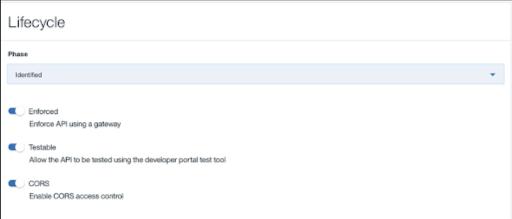
9. Click Security Definitions in the sidebar to bring up the Security Definitions panel. ClientIdHeader security definition exists, and Option 1 is active with the client header in the Security section (API Key).
10. Select Paths from the sidebar to open the Paths panel. By clicking the Add Path icon, you can create a new path. The icon for creating a path.
11. Replace the default path segment in the Path field with /details. When an operation is called, this path segment is appended to the API's URL.
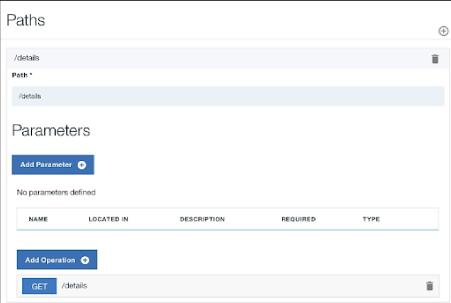
12. Your Path already contains a single GET operation. To expand the settings dialogue, click the GET button.
13. As shown in the table, provide the operation a summary and a description.

14. The Definitions panel will appear when you click Definitions in the sidebar. By selecting the Add Definition icon, you can create a new Definition. The symbol that says "Add Definition."
15. By selecting new-definition-1, you may make your new definition even more comprehensive. Enter the address and a description of the address object's format in the Name field.
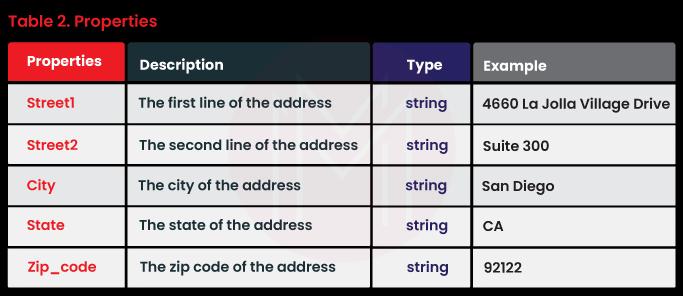
16. Configure the Properties definition as shown in the table using the same Definitions panel. After altering the default property, click Add Property and modify the default values to add new properties.
17. By clicking the Add icon, you may add a second definition. In the Definitions panel, click the Add definition icon.
18. Name the definition branch and write The format of the branch field in the Description field.
19. Create new properties and change the default property in the branch definition to have the properties given in the following table. By clicking Add Property, you can create new properties.
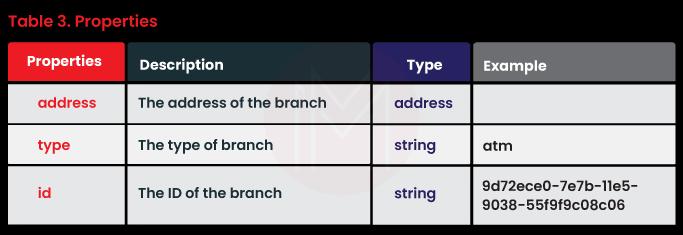
20. To access the Paths panel, click Paths in the sidebar. To extend the available options for the /details Path, click GET. By choosing the Schema field and selecting a branch from the drop-down list, include the branch definition in the GET operation Status Code 200 response.
21. Go to the submenu navigation bar and select the Assemble tab to access the assembled view.
22. You may access the invoke policy property sheet by selecting the invoke label.
23. According to the table below, fill in the Title, Description, and URL columns. When your API is called, it now uses the response from the current Branches API. The response of this API is not transformed in this lesson, and the caller receives the complete answer.
24. Save your work by clicking the symbol. To keep your changes, click the Save icon.
25. To see your API’s OpenAPI (Swagger 2.0) specification, go to the Source tab and choose it. This definition includes all of the configurations you've done, whether it's as part of the normal OpenAPI (Swagger 2.0) schema or the x-IBM-configuration extension.
Your REST API has been created.
Conclusion
We hope this tutorial provides detailed information about IBM API connect. The API economy, which is a dynamic interchange of interactions and transactions of services, assets, data, and ideas between developers, businesses, and consumers, includes all of these characteristics of APIs. With the rise of cloud computing and cognitive systems, the API economy will continue to expand and flourish in the coming years.
 On-Job Support Service
On-Job Support Service
Online Work Support for your on-job roles.

Our work-support plans provide precise options as per your project tasks. Whether you are a newbie or an experienced professional seeking assistance in completing project tasks, we are here with the following plans to meet your custom needs:
- Pay Per Hour
- Pay Per Week
- Monthly
| Name | Dates | |
|---|---|---|
| IBM API Connect Training | Jan 06 to Jan 21 | View Details |
| IBM API Connect Training | Jan 10 to Jan 25 | View Details |
| IBM API Connect Training | Jan 13 to Jan 28 | View Details |
| IBM API Connect Training | Jan 17 to Feb 01 | View Details |

Madhuri is a Senior Content Creator at MindMajix. She has written about a range of different topics on various technologies, which include, Splunk, Tensorflow, Selenium, and CEH. She spends most of her time researching on technology, and startups. Connect with her via LinkedIn and Twitter .




